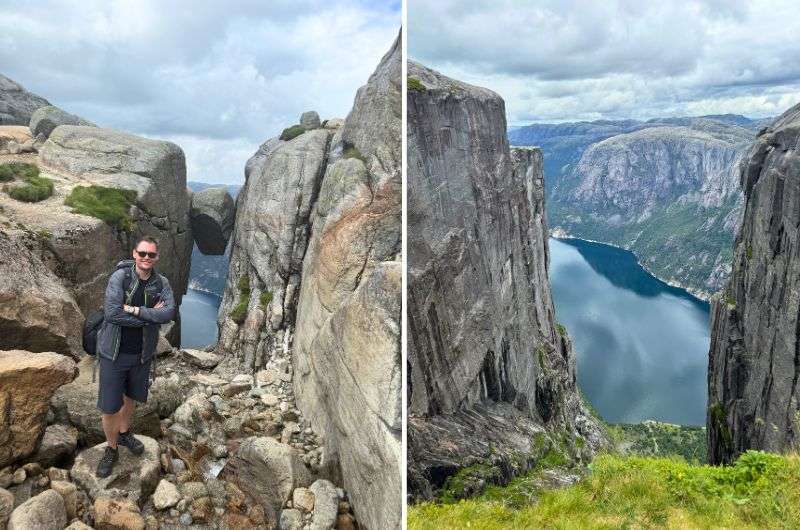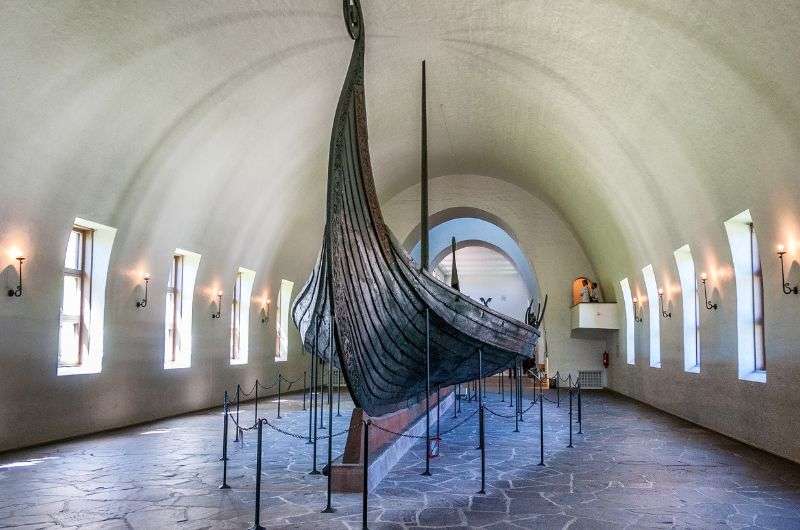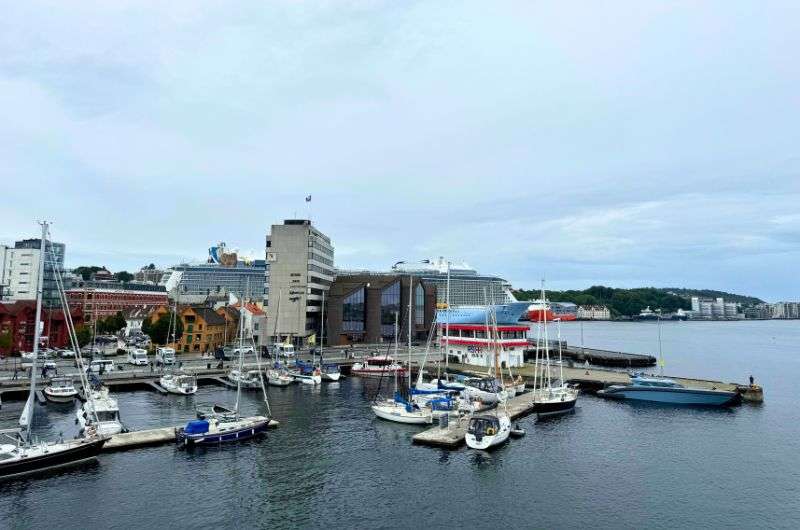10 Things to Do in Stavanger, Norway + 3-Day Itinerary Notes


If you’re looking for things to do in Stavanger, Norway’s third-largest city on the North Sea coast, let me get right to the point for you. Prepare for a fun mix of Viking history, colorful streets, and, yes, an oil-fueled economy that they just won’t shut up about.
Stavanger went from Viking stronghold to thriving modern city, thanks largely to the precious black gunk under the sea. This is why it’s known as the “oil capital” of Norway.
Today, about 350,000 people live in Stavanger. Over a fifth of them are immigrants drawn to this very lucrative industry—a career path with perks that include great pay, a bit of sea breeze, and a surprising amount of fish. What’s not to love, right?
Fun fact: Stavanger was founded in 1125 and is one of the oldest settlements in Norway. Yet, despite its age, the city has a modern sort of energy, which makes up for its mediocre summer temperatures. (When I went in July, it managed to get up to 25 °C [77 °F] one day, and the whole population looked like it was suddenly gearing up to go to Hawaii.)

The picturesque town of Stavanger
In this article, I’ll take you through my top 10 things to do in Stavanger and the Stavanger region, and I've also included my own, tried-and-tested 3-day itinerary to help you make the most of your visit. From a historic cathedral and interactive museums to insane fjord views and (literally) vibrant street life, Stavanger has more to offer than you might expect. I’m here to prove it!
Trying to plan a longer trip to Norway? Be sure to check out my 7-day Norwegian itinerary:
My top 10 things to do in Stavanger
- Hike Pulpit Rock
- Hike Kjerag to see Kjeragbolten
- Go on a Lysefjord cruise
- Visit the Norwegian Petroleum Museum
- Explore Gamle Stavanger (Old Stavanger)
- Walk down Fargegaten, the colorful street
- Visit Stavanger Cathedral
- Visit the Sverd i fjell monument
- Visit the Norwegian Canning Museum
- Visit the Museum of Archaeology
Visiting Stavanger: My hotel and restaurant tips
- Where to stay in Stavanger: Ydalir Hotel near Stavanger University
- Where to eat in Stavanger: Olivia Torget | Døgnvill Burger
Things to do in Stavanger: map

Map of Stavanger, pinpointing the best places of interest
Lysefjord map

Map of Lysefjord, pinpointing the trailheads of the Pulpit Rock and Kjerag hikes
Sometimes, all you need to do is take the first step... I've filtered out the best hotels in Stavanger for you
Save it for yourself to come back to later, or share with your friends on social media!
1. Hike Pulpit Rock
- Distance: 8 km (5 mi), out-and-back
- Elevation gain: 398 m (1,306 ft)
- Difficulty: Moderate
- Hiking time: 4–5 hours
- Trailhead: Google Maps link to trailhead

Pulpit Rock
How would you like to get your adrenaline pumping by standing on a flat stone platform that juts out over a 600-meter drop? Kick-start your visit to Stavanger with this bad boy!
If you only have time to do one hike near Stavanger, I’d say it should be this one. The Pulpit Rock (or Preikestolen) hike is an unforgettable four-hour experience—Lysefjord realness meets Yosemite vibes. It’s challenging but not impossible, the views are breathtaking, and the sense of accomplishment when you reach the top is second to none.
You can drive to the Pulpit Rock trailhead (Google Maps link here) from Stavanger in less than an hour, which means you can be there, up the cliff and back again in half a day. And before you go, make sure you read this extensive article on Pulpit Rock, with personal tips from yours truly...
Find all you need to know about hiking Pulpit Rock right here:

2. Hike Kjerag to see Kjeragbolten
- Distance: 9.3 km (5.8 mi), out-and-back
- Elevation gain: 583 m (1,913 ft)
- Difficulty: Hard
- Hiking time: 6 hours
- Trailhead: Google Maps link to trailhead

Kjerag hike and me NOT getting on that stone
And if Pulpit Rock wasn’t exciting enough for you, try this hike for size. Kjerag is another peak around Lysefjord (the highest one, in fact). It’s a popular choice of hike because of its iconic stone boulder, Kjeragbolten, which is wedged between two cliffs. The drop here is around 1,000 m (3,280 ft). Surreal, staggering, and stomach-churning.
Now, I’m not saying you have to be mad to take on this hike, but the objective of most who do is to get a photo of themselves standing on the boulder. Personally, I passed on this opportunity because I quite like life.
To put cynicism aside for a moment, the Kjerag and Kjeragbolten hike is an ultimately thrilling and wonderful thing to do near Stavanger. I was very proud of myself for having conquered it, and I’d urge anyone with good physical fitness to attempt to do the same.
You can read more about my Kjerag experience in this article.
Note: It’s nearly impossible to hike up Kjerag in winter, so save your soul and just don’t try.
3. Go on a Lysefjord cruise

During a Lysefjord cruise you will see beautiful Norwegian nature, rocks and even waterfalls for that matter
- Price: NOK 790 (USD 72)
If you’re not into hiking, don’t worry, it’s okay to be wrong sometimes. But also, don’t feel like you have to miss out on the magic of Lysefjord. Simply board a boat in Stavanger, sit back for three hours, and take in some of the best scenery offered by one of Norway's most beautiful fjords.
Rødne Fjord Cruise is the company you want to go with. They run three trips every day in the summer and at less regular intervals in the winter, for a cool NOK 790 (USD 72) per person.
I didn’t think the price was so terrible for three hours of a 460-meter (1,509-foot) deep, glacially carved fjord, and fittingly incredible views. Plus, the ride is incredibly quiet, thanks to Norway’s push for green, electric transport; AND you get an audio guide with plenty of fun fjord facts.
Pro tips: Book online in advance, and even if it’s warm in Stavanger, bring a jacket. It gets chilly out on the water!
4. Visit the Norwegian Petroleum Museum

The Norwegian Petroleum Museum and me pretending to be the CEO of the oil industry in Norway
- Price: NOK 180 (USD 16)
- Opening hours: 10 am–7 pm daily (June–August); 10 am–4 pm Monday–Saturday, 10 am–6 pm Sunday (September–May)
Hands up—who wants to see some exhibits on thick black gunge, housed in a giant tin maze? Seriously, the Norwegian Petroleum Museum might be a bad dream if you’re a climate activist, but for those of us who live in the real world, it’s cool, original, and mind-blowing. (And to be fair, there is a good bit from the climate change angle.)
Plan for at least two hours here as there’s a ton to see. Oil is Norway’s economic backbone, after all, and this is Stavanger’s most visited museum. It’s super interactive, too! Don’t miss trying on the Helly Hansen survival suit—a fun way to see what oil workers deal with. All in all, you won’t find anything like this place anywhere else, and I can’t recommend it enough.
Crazy fact from this museum: Norway’s unique model taxes oil companies at 51%, and all that revenue goes into the world's largest pension fund.
5. Explore Gamle Stavanger (Old Stavanger)

White wooden houses are typical for Gamle Stavanger
Gamle Stavanger is Stavanger’s Old Town. As everyone knows, no trip to any European city is complete without a stomp around its old town, so you’d better get this in at some point among your other things to do in Stavanger.
With 173 well-preserved 18th-century cottages, Old Stavanger is a tiny but charming slice of history. It definitely didn’t look like any other European old town I’d been to. As a result, I felt a bit self-conscious that I was awkwardly snapping photos of every one of those white wooden houses. I’m sure the people who live there are used to it...
Gamle Stavanger only takes around 15 minutes to get through, so it's just a short walk. But depending on how keen a photographer you are, you could even stretch your visit to an hour. Bonus points if you catch a cruise ship docked nearby, making the houses look even tinier in comparison.
6. Walk down Fargegaten, the colorful street

Fargegaten streets with colorful houses
Put your sunglasses on and take a stroll down Fargegaten in downtown Stavanger. Each building on this street is painted a different, unapologetically bold color, so it’s no surprise that it’s the city’s most Instagrammable spot.
It’s basically a more intense version of Tobermory in Scotland (read my article on the best things to do on the Isle of Mull to see what I mean). Or, if you like, a condensed version of Copenhagen’s Christiania; just with less hash.
Originally, this was just another dull and drab street. It was later transformed by local artists and eventually became a hippy hub packed with indie shops, cafés, and galleries. Today, I’d say it’s a refreshing spot in an otherwise traditionally Scandinavian (read: monochrome) city, perfect for a coffee stop. I went to Bøker og Børst.
As you wander down Fargegaten, you’ll be acutely aware that each corner practically begs to have its photo taken. But don’t dawdle too much because you’ll likely hold up other tourists behind you—it can be a busy place.
7. Visit Stavanger Cathedral

Stavanger Cathedral
- Price: NOK 75 (USD 7)
- Opening hours: 10 am–3 pm Monday–Saturday (as a general rule; will sometimes close for events with little notice)
Fun fact: Stavanger Cathedral, or Stavanger domkirke, is Norway's most preserved cathedral. Intrigued? You should be.
Because it remains almost completely untouched since the 14th century, entering Stavanger Cathedral really feels like you’re stepping into a time capsule; I half-expected a medieval knight to stroll by. It’s a real gem of medieval architecture.
This Romanesque-Gothic beauty survived fires, storms, and countless renovations, yet its character remains stunningly intact. The intricate woodwork and stained glass create a peaceful, almost mystical vibe, perfect for a quiet moment before diving back into Stavanger’s bustle.
Trust me—it's not every day you walk through history this old and well-preserved. Plus, it’s one of the cheapest things in town!
8. Visit the Sverd i fjell monument

Sverd i fjell monument—the legacy of the Vikings
Located around 6 km (3.73 mi) southwest of Stavanger city center, the Sverd i fjell (“Swords in Rock”) monument is a sight you don’t want to miss! Three massive swords are planted on Møllebukta bay, commemorating the legendary battle in 872 in which King Harald Fairhair united Norway.
These three swords are a mix of Viking power and epic photo-op. I was surprised by their size; they’re huge, but still smaller than my inner Viking had imagined.
The wholesome thing about Sverd i fjell is that the swords are forever rooted in stone, supposedly symbolizing peace. This is where you get your quick history fix, say “aawh,” and take a scenic selfie by the bay.
9. Visit the Norwegian Canning Museum

Norwegian Canning Museum
- Price: NOK 140 (USD 13)
- Opening times: 11 am–4 pm Tuesday–Sunday
Only in Norway will you find a museum dedicated to canned fish. If you thought the Petroleum Museum was niche, try surrendering yourself to this quirky, and honestly fascinating look into Stavanger’s past as a sardine-canning powerhouse. (I know—what a flex!)
Fun fact: At the industry’s peak in the 1920s, more than 70% of Norway’s exported canned fish production came from Stavanger.
Housed in a former cannery (yep, that’s what it’s called), this place shows you every step of the process: from brining to smoking to sealing. They even have an old-school production line and vintage machinery that bring the 19th-century sardine craze to life.
I went in curious and left around 90 minutes later surprisingly informed (and with a fish craving). The museum is located right in the middle of Gamle Stavanger, and on some days, they smoke real sardines that you can try, leaving a temporary but particular smell in the air. Again, I’m sure the people who live there are used to it...
10. Visit the Museum of Archaeology

From the Viking exhibition
- Price: NOK 100 (USD 9)
- Opening hours: 10 am–4 pm daily (May–August); 11 am–3 pm Wednesday–Saturday, 11 am–4 pm Sunday, 11 am–8 pm Tuesday (September–April)
Stavanger’s Museum of Archaeology takes you back—way back—to Norway’s prehistoric days. You’ll find everything here from ancient Viking swords to mysterious Bronze Age artifacts, all expertly preserved and presented. They even have a real Viking-era burial display (yep, bones and all), which is both eerie and incredible.
I went in thinking I'd just browse, but the exhibits are so well done, I was hooked and spent a couple of hours here. There’s even a reconstructed Iron Age farm outside! It’s fascinating to see how people survived, thrived, and fashioned weapons.
It was too late for me anyway, but be warned: this place might make a Viking history buff out of anyone.
BONUS: Spot Stavanger’s street art

Street art in Stavanger
Did you know that Stavanger was also famous for its street art? It’s tasteful stuff, too! I came across walls painted with surreal portraits, random cartoons, and everything in between, and they all certainly add character to the place.
Thanks to the Nuart Festival, which used to happen every year in Stavanger until it was taken over by Aberdeen in Scotland, new murals were always popping up. It’s nice that they’re there to stay, even if the festival is no more. They make the city seem a bit like a giant open-air gallery.
How to do Stavanger in 3 days: itinerary notes
In my opinion, 3 days is the optimum amount of time to spend in Stavanger. This gives you plenty of time to get at least one hike under your belt. At the same time, it’s not so long that you’ll run out of things to do in what is ultimately a small city.
Reminder: I stayed at Ydalir Hotel near Stavanger University and recommend you do too.

Stavanger can be used for relaxing walks through picturesque streets and museums, as well as a base for serious hikes
Take notes for your own itinerary—this is exactly how I spent the three days I had in Stavanger...
Day 1 (Lysefjord and hike #1)
- Went on a Lysefjord cruise (for 3 hours)
- Hiked Pulpit Rock (for 4 hours)
Day 2 (Relaxing in Stavanger)
- Explored Gamle Stavanger and visited the Norwegian Canning Museum (for 2 hours)
- Visited the Museum of Archaeology (for 2 hours)
- Visited Stavanger Cathedral (for 30 minutes)
- Walked down Fargegaten (for 1 hour)
- Visited the Norwegian Petroleum Museum (for 2 hours)
- Visited the Sverd i fjell momument (for 1 hour)
Day 3 (Hike #2—yes, the hard one)
- Hiked Kjerag and Kjeragbolten (for 8 hours)
- Collapsed (still recovering, to be honest)

We enjoyed our time in Stavanger
Sometimes, all you need to do is take the first step... I've filtered out the best hotels in Stavanger for you
Save it for yourself to come back to later, or share with your friends on social media!
FAQ 1: Is Stavanger, Norway worth visiting?
Stavanger is absolutely worth visiting. First of all, Stavanger makes an ideal base if you want to take on epic hikes around Lysefjord such as Pulpit Rock. What’s more, the city itself is visually charming, from the white houses of Gamle Stavanger to the multicolored Fargegaten, not to mention the many works of tasteful street art.
There are several museums in Stavanger that offer a surprisingly fun dive into Norwegian life, such as the Norwegian Petroleum Museum. And finally, you’ve got fjord cruises and top-notch restaurants all in one relatively compact area. Even though it’s quite a small city, you won’t run out of things to do in Stavanger.
FAQ 2: What is Stavanger known for?
Stavanger is known for many things, but perhaps is most known today for its street art, being the gateway to Lysefjord, and being the “oil capital” of Norway.
FAQ 3: How do you spend a day in Stavanger?
If you only have one day in the city itself (i.e. you’re not planning any hikes), make sure you hit these very best things to do in Stavanger:
- Fargegaten
- The Sverd i fjell monument
- The Norwegian Petroleum Museum
- Gamle Stavanger (Old Stavanger)
- The Norwegian Canning Museum

Stavanger is expensive because of the Norwegian oil businesses located there
FAQ 4: Is it expensive in Stavanger?
Stavanger is known for being expensive and has been ranked among the world’s most expensive cities within the last decade or so. The primary reason for this is that Stavanger is the hub of Norway's oil industry. This means that the city offers some incredibly high salaries, which drives up the cost of goods, services, and housing, for both locals and tourists.
FAQ 5: Is Stavanger walkable?
Yes, Stavanger is very walkable. The city center is compact, and many of the main attractions, like Gamle Stavanger, Fargegaten, Stavanger Cathedral, and the waterfront, are within walking distance of each other. Plus, Stavanger's pedestrian-friendly layout makes it easy to wander without needing a car. Just be prepared for a few hills!
Note: Some of the points of interest on this list aren’t in Stavanger city center, namely, the Sverd i fjell monument, and both the Pulpit Rock and Kjerag hike trailheads. Ideally, you should hire a car to get to these places.
This post contains affiliate links. I earn a small commission if you make bookings through my links, at no additional cost to you. Thank you for your support!
















Comments | Thoughts? Give us a shout!